International Journal of Intelligent Systems and Applications @ijisa
Статьи журнала - International Journal of Intelligent Systems and Applications
Все статьи: 1214
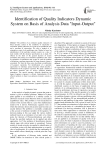
Identification of Quality Indicators Dynamic System on Basis of Analysis Data "Input-Output"
Статья научная
The problem of an estimation quality indicators of linear dynamic system in the conditions of uncertainty is considered. Quality indicators are a point of an equilibrium state and a spectrum of eigenvalues. We offer a method of an estimation a point of an equilibrium state. Method is based on identification of the particular solution system on a class of static models with the dynamic specification on an input. We offered on the basis of the general decision of system procedures and criteria of an estimation equilibrium state. After an estimation of equilibrium state system in work the problem of definition a spectrum eigenvalues of linear dynamic system is considered. We form the time series describing a modification of Lyapunov exponents. For identification of a spectrum eigenvalues we introduce special structures which describe a modification of the Lyapunov exponent. We apply a method of the secant structures and we receive spectrum tentative estimations. The special structure, allowing identifying the largest Lyapunov exponent, is offered. Generalization of the offered methods on linear non-stationary dynamic systems is given.
Бесплатно
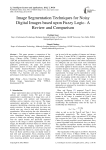
Статья научная
This paper presents a comparison of the three fuzzy based image segmentation methods namely Fuzzy C-Means (FCM), TYPE-II Fuzzy C-Means (T2FCM), and Intuitionistic Fuzzy C-Means (IFCM) for digital images with varied levels of noise. Apart from qualitative performance, the paper also presents quantitative analysis of these three algorithms using four validity functions-Partition coefficient (V_pc), Partition entropy (V_pe), Fukuyama-Sugeno (V_fs), and Xie-Beni (V_xb) functions and also compared the performance on the basis of their execution time.
Бесплатно
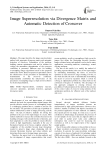
Image Superresolution via Divergence Matrix and Automatic Detection of Crossover
Статья научная
The paper describes the image superresolution method with aggregate divergence matrix and automatic detection of crossover. Formulation of the problem, building extreme optimization task and its solution for solving the automation determination of the crossover coefficient is presented. Different ways for building oversampling images algorithms based on the proposed method are shows. Based on practical experiments shows the effectiveness of the procedure of automatically the determination of the crossover coefficient. Experimentally established the effectiveness of the procedures oversampling images at high zoom resolution by the developed method.
Бесплатно
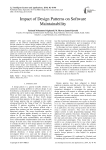
Impact of Design Patterns on Software Maintainability
Статья научная
This paper mainly studies the effect of design patterns on the Software maintainability. Design patterns describe solutions for common design problems and they were introduced to improve software quality and accelerate software development. However, there are some difficulties to choose an optimal pattern adapted to a certain application and problem. So until now the results on the effect of design patterns on software quality are controversial. In this context, we propose a tool for design pattern guided that retrieves the appropriate pattern with respect to software maintainability from a repository of patterns. It measures the maintainability of design pattern by some metrics and candidate the more maintainable pattern to the designer or developer. It provides a support for decision making during system design and refactoring. As the results, the decision of applying a certain design pattern is usually a trade-off since the effect of design pattern on software maintainability is influenced by some factors such as the pattern size and the prior expertise of the developer.
Бесплатно
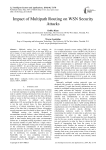
Impact of Multipath Routing on WSN Security Attacks
Статья научная
Multipath routing does not minimize the consequences of security attacks. Due to this many WSNs are still in danger of most security attacks even when multipath routing is used. In critical situations, for example, in military and health applications this may lead to undesired, harmful and disastrous effects. These applications need to get their data communicated efficiently and in a secure manner. In this paper, we show the results of a series of security attacks on a multipath extension to the ad hoc on-demand distance vector AODV protocol, AOMDV. It is proved that many security parameters are negatively affected by security attacks on AOMDV, which is contradictory to research claims. This means that alternative refinements have to be made to present multipath routing protocols in order to make them more effective against network security attacks.
Бесплатно
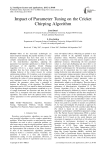
Impact of Parameter Tuning on the Cricket Chirping Algorithm
Статья научная
Most of the man-made technologies are nature-inspired including the popular heuristics or meta-heuristics techniques that have been used to solve complex computational optimization problems. In most of the meta-heuristics algorithms, adjusting the parameters has important significance to obtain the best performance of the algorithm. Cricket Chirping Algorithm (CCA) is a nature inspired meta-heuristic algorithm that has been designed by mimicking the chirping behavior of the cricket (insect) for solving optimization problems. CCA employs a set of parameters for its smooth functioning. In a meta-heuristic algorithm, controlling the values of various parameters is one of the most important issues of research. While solving the problem, the parameter values have a potential to improve the efficiency of the algorithm. The different parameters used in CCA are tuned for better performance of the algorithm through experiments conducted on a set of sample benchmark test functions and then, the fine-tuned CCA is compared with some other meta-heuristic algorithms. The results show the optimal choice of the various parameters to solve optimization problems using CCA.
Бесплатно
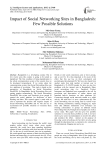
Impact of Social Networking Sites in Bangladesh: Few Possible Solutions
Статья научная
Bangladesh is a developing country. But in few recent years this country is going to be turned as digitalized. The first condition of being digitalization is the whole communication system of the country have to be developed tremendously. If we notice about the communication system, then Social Networking Sites can be a platform of revolution. This study is based on the perspective of Bangladesh on Social Networking Sites(SNS). In Bangladesh, Social Networking Sites are getting popular tremendously. The Social Networking Sites(SNS) like twitter and Facebook gives people in general the useful platform for disclosure of their thinking and ideas. This research paper is made with an aim to represent the positive and negative impact of Social Networking Sites(SNS) and we will also try to recommend few possible solutions to overcome these problems.
Бесплатно
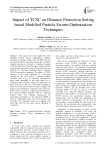
Impact of TCSC on Distance Protection Setting based Modified Particle Swarm Optimization Techniques
Статья научная
This paper presents the application of the Modified Particle Swarm Optimization (MPSO) technique for optimal settings zones for MHO distance relay protect 400 kV single transmission line of Eastern Algerian transmission networks at Algerian Company of Electrical and Gas (Group Sonelgaz) compensated by series Flexible Alternative current Transmission System (FACTS) i.e. Thyristor Controlled Series Capacitor (TCSC) connected at midpoint. The effects of TCSC insertion on the total impedance of a protected transmission line with respect to injected variable reactance value (X_(TCSC)) in capacitive and inductive boost mode depending of the firing angle (α) is considered. The modified setting zone protection for three zones (Z_(1), Z_(2) and Z_(3)) is have been investigate in order to prevent circuit breaker nuisance tripping and improve the performances of distance relay protection. In this work our aim is to compare the performance of the proposed MPSO algorithm with an analytical method (AM). The findings demonstrate the outstanding performance of the proposed MPSO in terms of computation speed, rate of convergence, and feasibility. The simulation results are compared with each other, and then the more perfect algorithm is considered.
Бесплатно
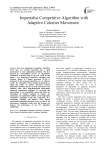
Imperialist Competitive Algorithm with Adaptive Colonies Movement
Статья научная
The novel Imperialist Competitive Algorithm (ICA) that was recently introduced has a good performance in some optimization problems. The ICA inspired by socio-political process of imperialistic competition of human being in the real world. In this paper, a new Imperialist Competitive Algorithm with Adaptive Radius of Colonies movement (ICAR) is proposed. In the proposed algorithm, for an effective search, the Absorption Policy changed dynamically to adapt the radius of colonies movement towards imperialist’s position. The ICA is easily stuck into a local optimum when solves high-dimensional multi-modal numerical optimization problems. To overcome this shortcoming, we use probabilistic model that utilize the information of colonies positions to balance the exploration and exploitation abilities of the Imperialist Competitive Algorithm. Using this mechanism, ICA exploration capability will enhance. Some famous unconstraint benchmark functions used to test the ICAR performance. Simulation results show this strategy can improve the performance of the ICA algorithm significantly.
Бесплатно
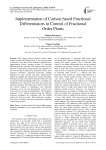
Implementation of Carlson based fractional differentiators in control of fractional order plants
Статья научная
This paper presents reduced integer order models of fractional differentiators. A two step procedure is followed. Using the Carlson method of approximation, approximated second iteration models of fractional differentiators are obtained. This method yields transfer function of high orders, which increase the complexity of the system and pose difficulty in realization. Hence, three reduction techniques, Balanced Truncation method, Matched DC gain method and Pade Approximation method are applied and reduced order models developed. With these models, fractional Proportional-Derivative and fractional Proportional-Integral-Derivative controllers are implemented on a fractional order plant and closed loop responses obtained. The authors have tried to reflect that the Carlson method in combination with reduction techniques can be used for development of good lower order models of fractional differentiators. The frequency responses of the models obtained using the different reduction techniques are compared with the original model and with each other. Three illustrative examples have been considered and their performance compared with existing systems.
Бесплатно
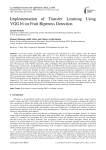
Implementation of Transfer Learning Using VGG16 on Fruit Ripeness Detection
Статья научная
In previous studies, researchers have determined the classification of fruit ripeness using the feature descriptor using color features (RGB, GSL, HSV, and L * a * b *). However, the performance from the experimental results obtained still yields results that are less than the maximum, viz the maximal accuracy is only 76%. Today, transfer learning techniques have been applied successfully in many real-world applications. For this reason, researchers propose transfer learning techniques using the VGG16 model. The proposed architecture uses VGG16 without the top layer. The top layer of the VGG16 replaced by adding a Multilayer Perceptron (MLP) block. The MLP block contains Flatten layer, a Dense layer, and Regularizes. The output of the MLP block uses the softmax activation function. There are three Regularizes that considered in the MLP block namely Dropout, Batch Normalization, and Regularizes kernels. The Regularizes selected are intended to reduce overfitting. The proposed architecture conducted on a fruit ripeness dataset that was created by researchers. Based on the experimental results found that the performance of the proposed architecture has better performance. Determination of the type of Regularizes is very influential on system performance. The best performance obtained on the MLP block that has Dropout 0.5 with increased accuracy reaching 18.42%. The Batch Normalization and the Regularizes kernels performance increased the accuracy amount of 10.52% and 2.63%, respectively. This study shows that the performance of deep learning using transfer learning always gets better performance than using machine learning with traditional feature extraction to determines fruit ripeness detection. This study gives also declaring that Dropout is the best technique to reduce overfitting in transfer learning.
Бесплатно
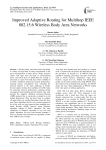
Improved Adaptive Routing for Multihop IEEE 802.15.6 Wireless Body Area Networks
Статья научная
Wireless Body Area Network has the ability to collect and send data on body measurement to the server through PDA or other device. Nodes (sensors) collect vital signs from the body or environmental factor and check them. In IEEE 802.15.6 routing is discussed as a part of the link layer where multihop is not fully considered. Improving network performance, reducing energy consumption, thus extending the network lifetime is the main challenge in BANs. Several studies mention that multihop for BANs helps for achieving network performance, reducing energy consumption and extending network lifetime. One work presents the Adaptive multihop tree-based Routing (AMR) protocol that is extensively evaluated in a real testbed deployment. They use fuzzy logic to combine all metrics they use. Another limitation is that they have used Prim's algorithm which is not a realistic approach. So in this work we have improved their multihop tree-based Routing (AMR) protocol using Kruskal's algorithm instead of Prim's algorithm. The time complexity of Kruskal's algorithm is way less than prims's algorithm. We have used network simulator 3 (NS3) to simulate and found that our algorithm is better than AMR if many of nodes.
Бесплатно
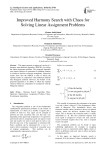
Improved Harmony Search with Chaos for Solving Linear Assignment Problems
Статья научная
This paper presents an improved version of a harmony meta-heuristic algorithm, (IHSCH), for solving the linear assignment problem. The proposed algorithm uses chaotic behavior to generation a candidate solution in a behavior similar to acoustic monophony. Numerical results show that the IHSCH is able to obtain the optimal results in comparison with traditional methods (the Hungarian method). However, the benefit of the proposed algorithm is its ability to obtain the optimal solution within less computation in comparison with the Hungarian method.
Бесплатно
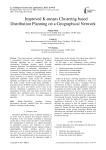
Improved K-means Clustering based Distribution Planning on a Geographical Network
Статья научная
This paper presents a distribution planning on a geographical network, using improved K-means clustering algorithm and is compared with the conventional Euclidean distance based K-means clustering algorithm. The distribution planning includes optimal placement of substation, minimization of expansion cost, optimization of network parameters such as network topology, routing of single/multiple feeders, and reduction in network power losses. The improved K-means clustering is an iterative weighting factor based optimization algorithm which locates the substation optimally and improves the voltage drop at each node. For feeder routing shortest path based algorithm is proposed and the modified load flow method is used to calculate the active and reactive power losses in the network. Simulation is performed on 54 nodes based geographical network with load points and the results obtained show significant power loss minimization as compared to the conventional K-means clustering algorithm.
Бесплатно
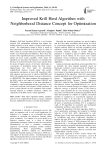
Improved Krill Herd Algorithm with Neighborhood Distance Concept for Optimization
Статья научная
Krill herd algorithm (KHA) is a novel nature inspired (NI) optimization technique that mimics the herding behavior of krill, which is a kind of fish found in nature. The mathematical model of KHA is based on three phenomena observed in the behavior of a herd of krills, which are, moment induced by other krill, foraging motion and random physical diffusion. These three key features of the algorithm provide a good balance between global and local search capability, which makes the algorithm very powerful. The objective is to minimize the distance of each krill from the food source and also from the point of highest density of the herd, which helps in convergence of population around the food source. Improvisation has been made by introducing neighborhood distance concept along with genetic reproduction mechanism in basic KH Algorithm. KHA with mutation and crossover is called as (KHAMC) and KHA with neighborhood distance concept is referred here as (KHAMCD). This paper compares the performance of the KHA with its two improved variants KHAMC and KHAMCD. The performance of the three algorithms is compared on eight benchmark functions and also on two real world economic load dispatch (ELD) problems of power system. Results are also compared with recently reported methods to establish robustness, validity and superiority of the KHA and its variant algorithms.
Бесплатно

Статья научная
As elliptic curve cryptography is one of the popular ways of constructing an encoding and decoding processes, public-key algorithms as its basis provide people a comfortable way of exchanging pieces of encoded information. As the time goes by, a lot of algorithms have emerged, some of them are still in use today; some others are still being developed into new forms. The main point of algorithm innovation is to reduce the number of processed operations during every possible step to find maximum efficiency and highest speed while performing the calculations. This article describes an improved method of the López-Dahab-Montgomery (LD-Montgomery) scalar point multiplication in terms of working with binary elliptic curves. It is shown in the article that the possible improvement lies in reordering the set of operations which is used in LD-Montgomery scalar point multiplication algorithm. The algorithm is used to compute point multiplication results of the curves over binary Galois Fields featuring the following m values: . The article also presents the experimental results based on different scalars.
Бесплатно

Improvement of GVSRM with Addressing the Interoperability Issues in Global Village
Статья научная
In today's globally networked environment, enterprises need collaborating using Information Technology (IT) and other tools to succeed in this dynamic and heterogeneous business environment. The Global Village Services Reference Model (GVSRM) is a model based on SOSA (Service Oriented Strategies and Architectures) ontology for global village services realization. In this model, three architectural abstraction layers have been considered for global village: ‘infrastructure for global village services’, ‘global village services provisioning’, and ‘using global village services’. Despite of relative completeness of this model, one of its obvious shortcomings is lack of attention to the crucial issue of interoperability in the global village. Based on this model, the grid of global village is comprised of VHGs (Virtual Holding Governance). The VHG is a temporary, scalable, dynamic cluster/association comprising of existing or newly service provider organizations which its aim is satisfying the requirements of global village actors through electronic processes. In this paper, we will propose a federated approach for interoperability among the VHGs of the global village and then improve the GVSRM by adding the corresponding interoperability components to it.
Бесплатно
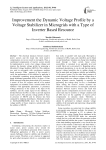
Статья научная
The electrical distances between reactive power sources and the loads that need reactive compensation are not too much in microgrids. Thus, a coordinated compensation of reactive sources should be implemented to avoid a fast voltage collapse and improve the dynamic voltage profile by proposing a MicroGrid Voltage Stabilizer (MGVS). This stabilizer was used in microgrids with synchronous machine based resources. Main purpose of this research is verify the performance of the stabilizer by applying it to microgrids containing power-electronic converter based distributed generations (DGs). So that a 21-bus IEEE microgrid with three photovoltaic (PV) resources is tested. At first, PV resource and all of its needed equipments, are modeled. Then a control model of the stabilizer with appropriate parameters, is presented. Voltage deficiency of the system is the input of the stabilizer, and the output signal of the stabilizer, is divided between the DGs in order to provide required reactive power. The dynamic voltage profile of buses in presence of MGVS and its absence has been compared by implying disturbances. Simulation results in MATLAB/SIMULINK show that the dynamic voltage profile of buses improves satisfactorily with the addition of MGVS.
Бесплатно
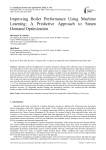
Статья научная
This paper explores the application of machine learning to enhance boiler efficiency and cost management at a Uranium Mine in Africa. The current steam control system relies on a feedforward loop, which adjusts based on slurry flow into the leach tank, and a feedback loop, which regulates steam to a setpoint. However, this method is inefficient, as it does not account for slurry temperature variations, leading to unstable control and suboptimal steam usage. To address these limitations, this study applies the Extra Trees algorithm to predict steam demand more accurately. The data-driven approach achieves a 6.6% reduction in steam consumption and a 2% decrease in heavy fuel oil (HFO) usage, resulting in cost savings and improved sustainability. Based on multiple evaluation metrics, the Extra Trees model proved to be the most accurate and consistent algorithm, achieving a 96.67% R-squared score and a Root Mean Square Error (RMSE) of 1131.37 kg, indicating minimal deviation between actual and predicted values. The findings highlight the shortcomings of traditional control strategies under fluctuating conditions and demonstrate how advanced feature engineering enhances predictive accuracy. By integrating machine learning into operational workflows, this research provides actionable insights to improve boiler performance, process stability, and overall efficiency.
Бесплатно
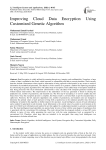
Improving Cloud Data Encryption Using Customized Genetic Algorithm
Статья научная
Data Encryption is widely utilized for ensuring data privacy, integrity, and confidentiality. Nowadays, a large volume of data is uploaded to the cloud, which increases its vulnerability and adds to security breaches. These security breaches include circumstances where sensitive information is being exposed to third parties or any access to sensitive information by unauthorized personnel. The objective of this research is to propose a method for improving encryption by customizing the genetic algorithm (GA) with added steps of encryption. These added steps of encryption include the data being processed with local information (chromosome's value calculated with computer-generated random bits without human intervention). The improvement in the randomness of the key generated is based on altering the population size, number of generations, and mutation rate. The first step of encrypting is to convert sample data into binary form. Once the encryption process is complete, this binary result is converted back to get the encrypted data or cipher-text. Foremost, the GA operators (population size, number of generations, and mutation rate) are changed to determine the optimal values of each operator to bring forth a random key in the minimum possible time, then local intelligence is headed in the algorithm to further improve the outcomes. Local Intelligence consists of local information and a random bit generated in each iteration. Local Information is the current value of a parent in each iteration at the gene level. Both local information and random bit are then applied in a mathematical pattern to generate a randomized key. The local intelligence-based algorithm can operate better in terms of time with the same degree of randomness that is generated with the conventional GA technique. The result showed that the proposed method is at least 80% more efficient in terms of time while generating the secret key with the same randomness level as generated by a conventional GA. Therefore, when large data are intended to be encrypted, then using local intelligence can demonstrate to be better utilized time.
Бесплатно

